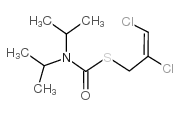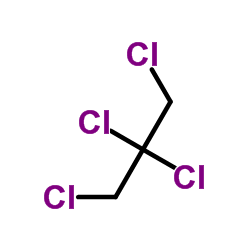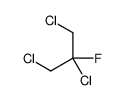96-19-5
| 中文名 | 1,2,3-三氯丙烯 |
|---|---|
| 英文名 | 1,2,3-trichloropropene |
| 英文别名 |
1,2,3-Trichlor-propen
EINECS 202-487-7 1,2,3-trichloro-propen (Z),(E)-1,2,3-trichloro-1-propene 1,2,3-Trichlor-propen-(1) 1,2,3-trichroro-1-propene MFCD00018931 1,2,3-Trichloro-1-propene 1,2,3-trichloropropylene Wln: G1ygu1g 1,2,3-trichloro-1-propen Propene,1,2,3-trichloro 1,2,3-trichlor-1-propene 1,2,3-trichloro-propene |
| 密度 | 1,43 g/cm3 |
|---|---|
| 沸点 | 145°C |
| 分子式 | C3H3Cl3 |
| 分子量 | 145.41500 |
| 闪点 | 82°C |
| 精确质量 | 143.93000 |
| LogP | 2.54420 |
| 外观性状 | 液体;Colorless to Almost colorless clear liquid |
| 折射率 | 1.487 |
| 储存条件 | 自用时以管道运输;外销可用铁桶包装。 |
| 稳定性 | 有毒,对人体的肺、胃有刺激作用,因产品中含少量氯丙酮,故具有催泪性。操作时应穿戴防护用具,附着在衣服上应立即更换。 |
| 分子结构 | 1、 摩尔折射率:30.39 2、 摩尔体积(cm3/mol):105.6 3、 等张比容(90.2K):250.2 4、 表面张力(dyne/cm):31.4 5、 极化率(10-24cm3):12.04 |
| 计算化学 | 1、 疏水参数计算参考值(XlogP):2.2 2、 氢键供体数量:0 3、 氢键受体数量:0 4、 可旋转化学键数量:1 5、 互变异构体数量: 6、 拓扑分子极性表面积(TPSA):0 7、 重原子数量:6 8、 表面电荷:0 9、 复杂度:57.1 10、同位素原子数量:0 11、确定原子立构中心数量:0 12、不确定原子立构中心数量:0 13、确定化学键立构中心数量:1 14、不确定化学键立构中心数量:0 15、共价键单元数量:1 |
| 更多 | 1. 性状:无色液体。 2. 密度(g/mL,20℃):1.414 3. 相对蒸汽密度(g/mL,空气=1):未确定 4. 熔点(ºC):未确定 5. 沸点(ºC,常压):142 6. 沸点(ºC, kPa):未确定 7. 折射率:1.5030 8. 闪点(ºC):未确定 9. 比旋光度(º):未确定 10. 自燃点或引燃温度(ºC):未确定 11. 蒸气压(mmHg,ºC):未确定 12. 饱和蒸气压(kPa, ºC):未确定 13. 燃烧热(KJ/mol):未确定 14. 临界温度(ºC):未确定 15. 临界压力(KPa):未确定 16. 油水(辛醇/水)分配系数的对数值:未确定 17. 爆炸上限(%,V/V):未确定 18. 爆炸下限(%,V/V):未确定 19. 溶解性:不溶于水。溶于乙醇、氯仿。 |
|
1,2,3-Trichloropropene (cis- and trans- mixture)
SAFETY DATA SHEET Section1. IDENTIFICATION Product name:1,2,3-Trichloropropene (cis- and trans- mixture) Section2. HAZARDS IDENTIFICATION GHS classification
PHYSICAL HAZARDS
Category 4 Flammable liquids HEALTH HAZARDS Category 4 Acute toxicity (Oral) Acute toxicity (Dermal)Category 3 Category 2 Acute toxicity (Inhalation) Skin corrosion/irritationCategory 2 Category 2A Serious eye damage/eye irritation Specific target organ toxicityRespiratory tract irritation - Single exposure [Category 3] ENVIRONMENTAL HAZARDSNot classified GHS label elements, including precautionary statements Pictograms or hazard symbols Danger Signal word Hazard statementsCombustible liquid Harmful if swallowed Toxic in contact with skin Fatal if inhaled Causes skin irritation Causes serious eye irritation May cause respiratory irritation Precautionary statements: [Prevention]Keep away from flames and hot surfaces. Do not breathe dust/fume/gas/mist/vapours/spray. Use only outdoors or in a well-ventilated area. Do not eat, drink or smoke when using this product. Wash hands thoroughly after handling. Wear respiratory protection. Wear protective gloves and eye/face protection. Section2. HAZARDS IDENTIFICATION [Response]IF INHALED: Remove victim to fresh air and keep at rest in a position comfortable for breathing. Immediately call a POISON CENTER or doctor/physician. IF SWALLOWED: Call a POISON CENTER or doctor/physician if you feel unwell. Rinse mouth. IF IN EYES: Rinse cautiously with water for several minutes. Remove contact lenses, if present and easy to do. Continue rinsing. If eye irritation persists: Get medical advice/attention. IF ON SKIN: Gently wash with plenty of soap and water. If skin irritation occurs: Get medical advice/attention. Remove/Take off immediately all contaminated clothing. Wash contaminated clothing before reuse. Call a POISON CENTER or doctor/physician if you feel unwell. [Storage]Store in a well-ventilated place. Keep container tightly closed. Store locked up. Dispose of contents/container through a waste management company authorized by [Disposal] the local government. Section3. COMPOSITION/INFORMATION ON INGREDIENTS Substance Substance/mixture: Components:1,2,3-Trichloropropene (cis- and trans- mixture) Percent:>95.0%(GC) CAS Number:96-19-5 Chemical Formula:C3H3Cl3 Section4. FIRST AID MEASURES Remove victim to fresh air and keep at rest in a position comfortable for breathing. Inhalation: Immediately call a POISON CENTER or doctor/physician. Skin contact:Remove/Take off immediately all contaminated clothing. Gently wash with plenty of soap and water. Call a POISON CENTER or doctor/physician. Eye contact:Rinse cautiously with water for several minutes. Remove contact lenses, if present and easy to do. Continue rinsing. If eye irritation persists: Get medical advice/attention. Ingestion:Call a POISON CENTER or doctor/physician if you feel unwell. Rinse mouth. Protection of first-aiders:A rescuer should wear personal protective equipment, such as rubber gloves and air- tight goggles. Section5. FIRE-FIGHTING MEASURES Suitable extinguishingDry chemical, foam, water spray, carbon dioxide. media: Unsuitable extinguishing Solid streams of water media: Specific hazards arising Take care as it may decompose upon combustion or in high temperatures to from the chemical:generate poisonous fume. Precautions for firefighters: Fire-extinguishing work is done from the windward and the suitable fire-extinguishing method according to the surrounding situation is used. Uninvolved persons should evacuate to a safe place. In case of fire in the surroundings: Remove movable containers if safe to do so. Special protectiveWhen extinguishing fire, be sure to wear personal protective equipment. equipment for firefighters: Section6. ACCIDENTAL RELEASE MEASURES Use extra personal protective equipment (self-contained breathing apparatus). Keep Personal precautions, protective equipment and people away from and upwind of spill/leak. Ensure adequate ventilation. Entry to non- emergency procedures: involved personnel should be controlled around the leakage area by roping off, etc. Environmental precautions: Prevent product from entering drains. Section6. ACCIDENTAL RELEASE MEASURES Methods and materials for Absorb spilled material in a suitable absorbent (e.g. rag, dry sand, earth, saw-dust). containment and cleaning In case of large amount of spillage, contain a spill by bunding. Adhered or collected up: material should be promptly disposed of, in accordance with appropriate laws and regulations. Prevention of secondary Remove all sources of ignition. Fire-extinguishing devices should be prepared in hazards:case of a fire. Use spark-proof tools and explosion-proof equipment. Section7. HANDLING AND STORAGE Precautions for safe handling Technical measures:Handling is performed in a well ventilated place. Wear suitable protective equipment. Prevent generation of vapour or mist. Keep away from flames and hot surfaces. Take measures to prevent the build up of electrostatic charge. Use explosion-proof equipment. Wash hands and face thoroughly after handling. Use a closed system, ventilation. Advice on safe handling: Avoid contact with skin, eyes and clothing. Conditions for safe storage, including any incompatibilities Storage conditions:Keep container tightly closed. Store in a cool, dark and well-ventilated place. Store locked up. Store away from incompatible materials such as oxidizing agents. Comply with laws. Packaging material: Section8. EXPOSURE CONTROLS / PERSONAL PROTECTION Engineering controls:Install a closed system or local exhaust. Also install safety shower and eye bath. Personal protective equipment Respiratory protection: Half or full facepiece respirator, self-contained breathing apparatus(SCBA), supplied air respirator, etc. Use respirators approved under appropriate government standards and follow local and national regulations. Impervious gloves. Hand protection: Eye protection:Safety goggles. A face-shield, if the situation requires. Skin and body protection: Impervious protective clothing. Protective boots, if the situation requires. Section9. PHYSICAL AND CHEMICAL PROPERTIES Physical state (20°C):Liquid Form:Clear Colorless - Very pale yellow Colour: Odour:No data available pH: No data available Melting point/freezing point:No data available Boiling point/range:145°C Flash point:82°C Flammability or explosive limits: Lower:No data available Upper:No data available Relative density:1.43 Solubility(ies): [Water]No data available [Other solvents]No data available Section10. STABILITY AND REACTIVITY Chemical stability:Stable under proper conditions. Possibility of hazardous No special reactivity has been reported. reactions: Open flame Conditions to avoid: Incompatible materials: Oxidizing agents Section10. STABILITY AND REACTIVITY Hazardous decomposition Carbon monoxide, Carbon dioxide, Hydrogen chloride products: Section11. TOXICOLOGICAL INFORMATION Acute Toxicity:ihl-rat LCLo:500 ppm/4H orl-rat LD50:616 mg/kg Skin corrosion/irritation: No data available Serious eyeNo data available damage/irritation: Germ cell mutagenicity: No data available Carcinogenicity: IARC =No data available NTP =No data available Reproductive toxicity:No data available RTECS Number:UD2450000 Section12. ECOLOGICAL INFORMATION Ecotoxicity: No data available Fish: Crustacea:No data available No data available Algae: Persistence / degradability: No data available BioaccumulativeNo data available potential(BCF): Mobility in soil Log Pow:No data available No data available Soil adsorption (Koc): Henry's LawNo data available constant(PaM3/mol): Section13. DISPOSAL CONSIDERATIONS Recycle to process, if possible. Consult your local regional authorities. You may be able to burn in a chemical incinerator equipped with an afterburner and scrubber system. Observe all federal, state and local regulations when disposing of the substance. Section14. TRANSPORT INFORMATION Hazards Class:6.1: Toxic substance. 2810 UN-No: Proper shipping name:Toxic liquid, organic, n.o.s. II Packing group: Section15. REGULATORY INFORMATION Safe management ordinance of dangerous chemical product (State Council announces on January 26, 2002 and revised on February 16,2011): Safe use and production, the storage of a dangerous chemical, transport, loading and unloading were prescribed. SECTION 16 - ADDITIONAL INFORMATION N/A |
|
毒理学数据: 1、 皮肤/眼睛刺激性 开放的刺激试验:兔子,皮肤接触:10mg/24H,反应的严重程度:严重。 标准的Draize试验:兔子,眼睛接触:50mg,反应的严重程度:中度。 2、急性毒性:大鼠经口LD50:616mg/kg;大鼠经吸入LCLo:500ppm/4H;兔子经皮肤接触LD50:640μL/kg; 3、其他多剂量毒性:大鼠经吸入TCLo:36ppm/6H/4W-C; 4、 致突变性 微生物鼠伤寒沙门氏菌突变:1μmol/plate; 人HeLa细胞的DNA抑制:1700μmol/L; CHEMICAL IDENTIFICATION
HEALTH HAZARD DATAACUTE TOXICITY DATA
MUTATION DATA
|
| 风险声明 (欧洲) | 20/21/22-36/37/38 |
|---|---|
| 安全声明 (欧洲) | S26-S36/37/39 |
| 危险品运输编码 | 2810 |
| RTECS号 | UD2450000 |
| 包装等级 | III |
| 危险类别 | 6.1(b) |
| 海关编码 | 2903299090 |
| 上游产品 0 | |
|---|---|
| 下游产品 4 | |
| 海关编码 | 2903299090 |
|---|---|
| 中文概述 | HS: 2903299090. 其他无环烃的不饱和氯化衍生物. 增值税率:17.0%. 退税率:9.0%. 监管条件:无. 最惠国关税:5.5%. 普通关税:30.0% |
| 申报要素 | 品名, 成分含量, 用途 |
| Summary | 2903299090 other unsaturated chlorinated derivatives of acyclic hydrocarbons。Supervision conditions:None。VAT:17.0%。Tax rebate rate:9.0%。MFN tariff:5.5%。General tariff:30.0% |







